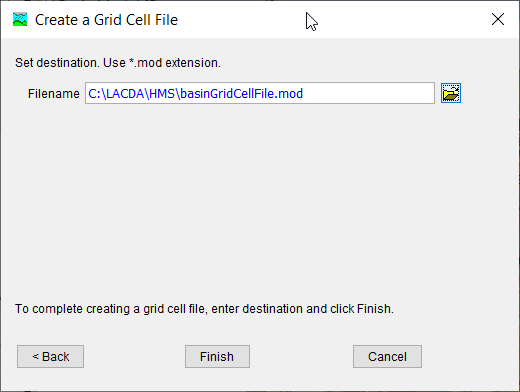Download PDF
Download page GIS Menu.
GIS Menu
Various GIS tools are available under the GIS menu (shown below). Many of these tools are not activated until other requirements are met; often this requirement is to have used other tools in this menu. For watershed delineation functions, the menu serves as a roadmap: the workflow proceeds from top to bottom in order.

Coordinate System
This tool allows you to set or view the coordinate system for a Basin Model. If a Basin Model is selected and it has a coordinate system assigned, selecting GIS | Coordinate System will show the current coordinate system (shown below).
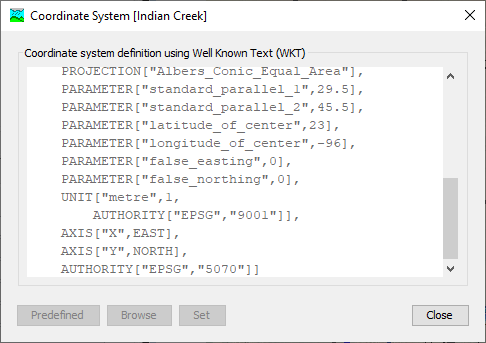
If a Basin Model is selected and no coordinate system has been assigned yet, selecting GIS | Coordinate System will prompt you to choose a coordinate system for the spatial referencing of the Basin Model. First, you will see a blank Coordinate System Selection prompt (shown below). Here you can choose to use a predefined coordinate system if you select the Predefined button. You may also choose to browse to GIS data that have a coordinate system reference and select it, extracting its coordinate system definition by pressing Browse. Finally, you may copy and paste an OGC WKT definition for a coordinate system in the text field.
Do NOT use an unprojected CRS, such as Geographic.
You may cancel the procedure by pressing Cancel. Once the text has been populated in the text field using either the predefined, existing GIS data or copied OGC WKT, you can set the basin coordinate system using the Set button.

HEC-HMS provides two predefined coordinate systems: Standard Hydrologic Grid (SHG) and Universal Transverse Mercator (UTM). Choosing the Predefined setting produces a selection dialog with two options (shown below).
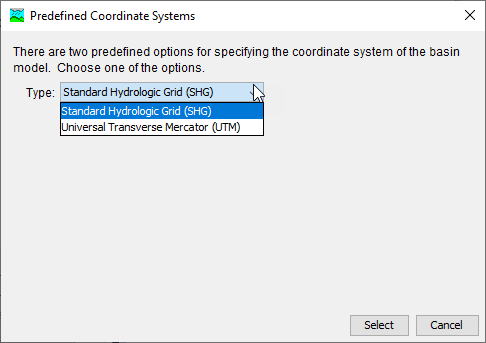
Using SHG requires no additional information. Using UTM requires the UTM zone, hemisphere, and datum to be specified (shown below). After setting the necessary options, pressing the Select button will populate the coordinate system selection dialog text field with the appropriate information. Pressing Cancel or the X will cancel the process.

Using the Browse option allows you to navigate to any GIS data with a coordinate system specification (e.g. shape file, raster data, .prj file, etc.) and select it so that HEC-HMS can extract its coordinate system specification (shown below).
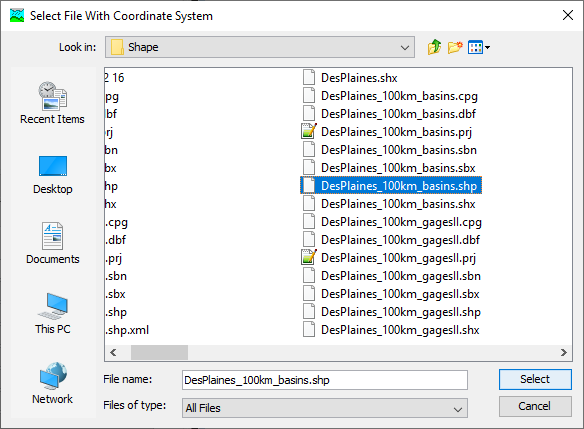
Alternatively, you may enter the coordinate system specification in the text field using an OGC WKT format. All three of these options will result in text in the text field (shown below). Once the coordinate system is specified in that text field, pressing Set will set the coordinate system for that Basin Model.
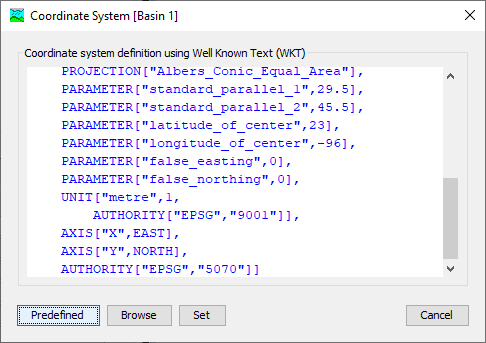
Reprojecting a Basin Model
Basin models can be reprojected from the Coordinate System dialog by using any of the methods described above to select a new projection, then clicking Set to commit the change. A progress bar will display while the following reprojection tasks are performed:
- Reproject the basin geodatabase (SpatiaLite) file. The basin geodatabase file has layers of vector data including subbasin and reach delineations, outlet points, etc.
- Reproject the basin terrain data. If a basin model is linked to a terrain data, a copy of the terrain data will be created in the new coordinate system during the reprojection process. The original terrain data will remain unaltered. If there is a discrepancy between the vertical units of the terrain data and the horizontal units of the new coordinate system, then the elevation values of the new terrain data will be automatically converted to match the horizontal units of the new coordinate system. The original terrain data file and any reprojected copies are stored in the "terrain" subdirectory of the main project directory.
Terrain-derived rasters during reprojection
If a basin model linked to a terrain data file is reprojected to a new coordinate system, only the "elevation.tif" raster is reprojected. Any rasters derived from the original terrain data file such as the sink fill raster ("sinkfill.tif") and the flow accumulation raster ("flowaccum.tif") will NOT be reprojected. Reprojecting involves resampling and the flow direction raster can not be resampled reliably to produce the same flowlines and watershed boundaries as the original. Terrain-derived rasters must be recreated in the new projection by repeating the operations under the GIS menu up to the Identify Streams operation.
Terrain Reconditioning
This tool will be available only if the following conditions are met:
- You have selected a Basin Model
- The Basin Model has a terrain data component assigned to it
Selecting GIS | Terrain Reconditioning will launch a two-step wizard that guides you through the process of building walls and/or burning streams in your elevation dataset. For the majority of use cases, the terrain reconditioning step can be skipped altogether as many watersheds will delineate accurately with the base terrain data that is assigned to the Basin Model. However, if the relief of your watershed is extremely flat or if you want to ensure that your HMS watershed delineations will exactly match published data such as hydrologic units found within the USGS's Watershed Boundary Dataset (WBD) or subbasin boundaries from a prior study, the build walls step within the terrain reconditioning tool can be very useful. The burn streams step is helpful if you want to impose a stream network onto a terrain dataset in order to improve channel definition. The figures below compare a base terrain dataset (left) and a HEC-HMS reconditioned dataset with sharply raised walls and a smoothly dropped channel (right).
The first step of the wizard allows you to build walls in the terrain. If you only desire to burn streams, you can skip to the second step of the wizard by clicking the Next button. A shapefile with watershed boundaries must be selected in order to build walls. A Smooth Raise Cell Buffer and Height and/or a Sharp Raise Height must be entered. If your goal is to force the HMS watershed delineations to match the input shapefile, a general recommendation is to enter a Smooth Raise Cell Buffer of 1 or 2 and a Smooth Raise height of 100 or more. The Smooth Raise Cell Buffer and height will gradually raise the elevations of all terrain cells that fall within the specified buffer. The cell elevations that touch the shapefile watershed boundaries will be raised to match the Smooth Raise height input and the surrounding cells within the buffer will be raised a lesser amount so that there is a gradual transition to the elevations of the cells that fall outside of the buffered area. For this reason, large cell buffers may result in long runtimes. A Sharp Raise Height will raise only the single line of cell elevations that touch the shapefile watershed boundaries (no buffering operation is performed). If both a Smooth Raise height and Sharp Raise Height are entered, the algorithm will first build a gradual wall within the buffer that matches the Smooth Raise height and then it will raise the single line of unbuffered wall cells an additional amount that matches the Sharp Raise Height. The vertical units of the Smooth Raise and Sharp Raise Heights will match the vertical units of the terrain data component assigned to the Basin Model. If negative heights are entered, the algorithm will dig trenches instead of building walls.

The second step of the wizard allows you to burn streams into the terrain. If you only desire to build walls, you can skip the second step by clicking the Finish button; however, when building walls, it is generally recommended to add a streamline shapefile on the second step as it will be used to breach the walls at intersections and allow for proper drainage (see next paragraph for more information). A shapefile with stream delineations must be selected in order to burn streams. As with build walls, a Smooth Drop Cell Buffer and Height and/or a Sharp Drop Height must be entered. One potential scenario when burning streams might be useful is in a 2D rain-on-grid analysis. If the terrain data does not sufficiently capture the stream network, then a shapefile with the desired stream delineations can be selected and burned into the terrain using the Smooth Drop Cell Buffer and Height. This will gradually lower the elevations of all terrain cells that fall within the buffer. The cell elevations that touch the stream shapefile polylines will be lowered to match the Smooth Drop Height input and the surrounding cells within the buffer will be lowered a lesser amount so that there is a gradual transition from the center of the stream to the overbank outside of the buffered area. For this reason, large cell buffers may result in long runtimes. This is especially true if your terrain resolution is fine and your stream network shapefile is very detailed. If both a Smooth Drop Height and Sharp Drop Height are entered, the algorithm will first burn a gradually deepening stream within the buffer that matches the Smooth Drop Height and then it will drop the unbuffered stream cells an additional amount that matches the Sharp Drop Height. The vertical units of the Smooth Drop and Sharp Drop Heights will match the vertical units of the terrain data component assigned to the Basin Model. If negative heights are entered, the algorithm will raise stream elevations instead of lowering them.

Burn Streams
When burning streams, it is recommended that the input streams file extends past the lowest point of the elevation raster, as seen in the below figure. This ensures that subsequent GIS processes yield an identified streams layer that reaches the most downstream portion of the underlying terrain.
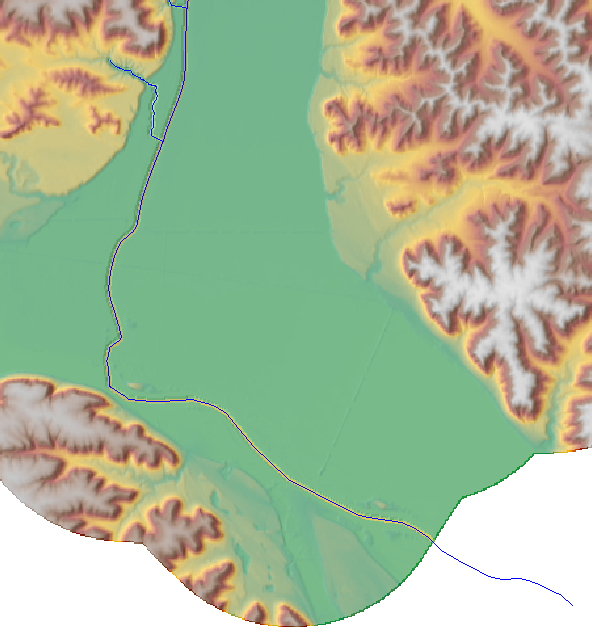
If both build walls and burn streams inputs are entered into the Terrain Reconditioning wizard, then the burn inputs will override the build inputs at places where they intersect. In other words, the burning of streams will breach the walls near intersections as seen in the figure below. This breaching operation ensures that all cells within the reconditioned terrain drain properly. The Smooth Drop Cell Buffer input is used to determine the width of the wall breach. A buffer input of 0 results in a breach width of one cell whereas larger buffer inputs result in larger breach widths at intersections. If you desire to build walls that are breached but do not wish to burn streams, simply input a burn streams filename but leave the other burn streams inputs at 0.
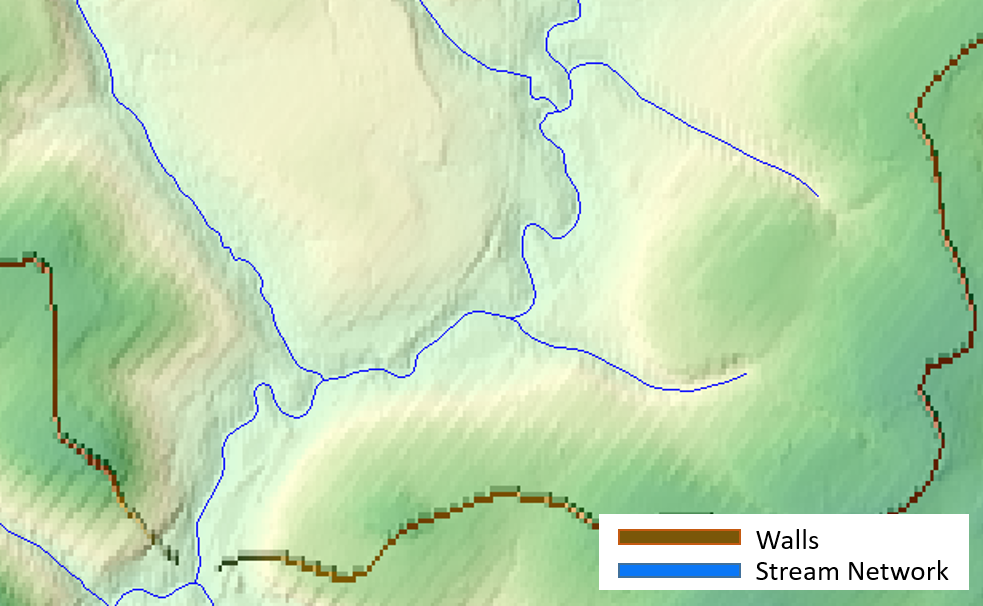
The figures below serve to highlight how the Smooth Drop and Sharp Drop parameters are applied when burning streams. The orange, hatched line represents a cross-section of a channel and the black dot represents the input burn streams shapefile. The gridded line of squares represents the resolution of the terrain data raster file. The Smooth Raise and Sharp Raise parameters are applied in the same way when building walls except that the terrain is raised instead of dropped.
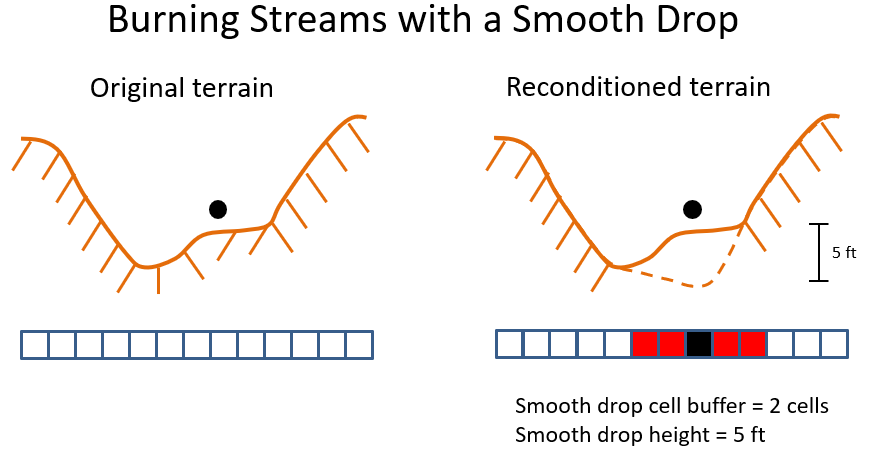
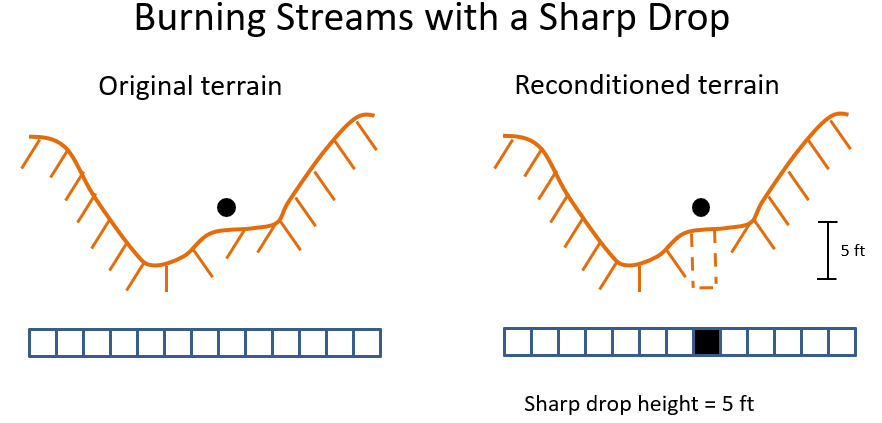

The Terrain Reconditioning Tool is sufficient for many typical build/burn operations. If complex build/burn operations are needed, it is recommended to use external GIS software to edit the terrain prior to importing into HEC-HMS.
Preprocess Sinks
This tool will be available only if the following conditions are met:
- You have selected a Basin Model
- The Basin Model has a terrain data component assigned to it
Selecting GIS | Preprocess Sinks will run a pit removal algorithm on the terrain data assigned to the selected Basin Model and produce a new, hydrologically-corrected DEM and a raster indicating the location of sinks and the depth they were filled. These two new rasters are added to the Map Layers list as Sink Fill and Sink Locations, respectively.
If you run the Terrain Reconditioning command first, this algorithm will use the reconditioned DEM with the wall and/or stream features. Otherwise, it will use the default dataset provided by the terrain data component.
If the terrain data assigned to the Basin Model is a hydrologically-corrected DEM, then this step is not necessary.
When the tool is run on large terrain datasets, it may produce an indefinite progress bar such as the one shown below. The indefinite progress bars purpose is to indicate progress, without estimating the time to completion.

Preprocess Drainage
This tool will be available only if the following conditions are met:
- You have selected a Basin Model
- The Basin Model has a terrain data component assigned to it
Selecting GIS | Preprocess Drainage will run an algorithm to determine the flow direction and flow accumulation for each grid cell in the terrain data raster. If you run the Preprocess Sinks command first, this algorithm will use the hydrologically-corrected DEM. If not, it will use the default elevation dataset provided by the terrain data component or, if available, the reconditioned elevation dataset. Both of the resulting rasters are added to the Map Layers list as Flow Direction and Flow Accumulation, respectively.
When the tool is run on large terrain datasets, it may produce an indefinite progress bar such as the one shown below.

Identify Streams
This tool will be available only if the following conditions are met:
- You have selected a Basin Model
- The Basin Model has a terrain data component assigned to it
- The Preprocess Drainage tool has been run
Selecting GIS | Identify Streams for the first time on a Basin Model will produce a prompt that requires you to enter the drainage accumulation threshold that will define where a stream starts, as shown below. A default is provided based on the resolution of the raster, but may produce too fine (or too coarse) of a threshold for your intended delineation. The value you enter will be the approximate drainage area for the subbasin elements that result.
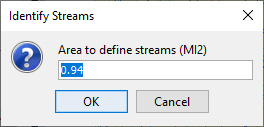
When the tool is run on large terrain datasets, it may produce an indefinite progress bar such as the one shown below.

If you have previously run the Identify Streams tool and you run it again, you will see the prompt shown below.
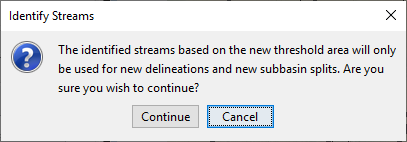
Break Points Manager
This tool will be available only if the following conditions are met:
- You have selected a Basin Model
- The Basin Model has a terrain data component assigned to it
- The Identify Streams tool has been run
The Break Points Manager (shown below) will allow you to view, rename, delete or modify the description of any break points defined in the Basin Model. By default, a Basin Model does not contain any break points. At least one break point, defining a watershed outlet, is necessary in order to perform a watershed delineation. Additional break points will force delineation of a subbasin element at that location.
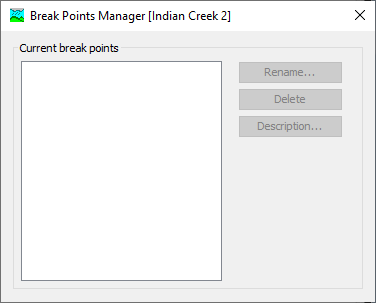
Break points are created using the Break Point Creation Tool in the Components Toolbar (shown below).

Selecting the Break Point Creation Tool and clicking in the Basin Model Map Window will produce a prompt (shown below) that asks for the name of the break point, as well as an optional description. If the text box is left blank, or the name is invalid, the Create button will not be available. Break points are shown on the basin map as red circles.

Delineate Elements
This tool will be available only if the following conditions are met:
- You have selected a Basin Model
- The Basin Model has a terrain data component assigned to it
- The Identify Streams tool has been run
- At least one break point has been defined
Selecting GIS | Delineate Elements for the first time on a Basin Model will produce a prompt that requires you to enter some naming scheme and delineation options (shown below). The Subbasin Prefix, Reach Prefix, and Junction Prefix options are text strings that prepend the automatic numbering scheme for the elements created in delineation. For example, if you enter S_ as the Subbasin Prefix, the subbasins created in the delineation process will be named S_1, S_2, and so on. The Insert Junctions option will automatically insert junctions above reaches when reaches are created in the delineation procedure. The Convert Break Points option will make any locations where there are break points, computation points in the Basin Model. The most downstream break point, which serves as a watershed outlet, will cause creation of a sink element at that location.
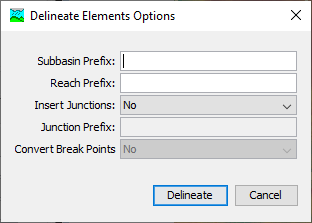
When the tool is run on large terrain datasets, it may produce an indefinite progress bar such as the one shown below.

The Delineate Elements tool can be re-run on a Basin Model, for example if you change the threshold for the Identify Streams tool and wish to re-delineate, or have made other changes to the Basin Model and wish to revert. When it is re-run, the Delineate Elements Options prompt (shown below) will appear, giving you an opportunity to change delineation options. If you run the tool with an existing delineation, you will see a dialog that indicates that a new delineation will delete an old one (shown in the following figure). Selecting Continue will delete existing elements and re-delineate.
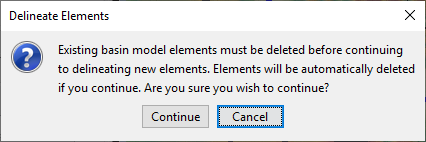
Split Elements
This tool will be available only if the following conditions are met:
- You have selected a Basin Model
- The Basin Model has a terrain data component assigned to it
- The Delineate Elements tool has been run
- Exactly one subbasin or reach element has been selected
Selecting GIS | Split Elements will allow you to choose where to divide a subbasin or reach element into two smaller elements.
Merge Elements
This tool will be available only if the following conditions are met:
- You have selected a Basin Model
- The Basin Model has a terrain data component assigned to it
- The Delineate Elements tool has been run
Selecting GIS | Merge Elements will allow you to choose to combine subbasin or reach elements into one larger element. HEC-HMS will not check to make sure that combining the elements makes hydrologic "sense"; it will only ensure that the elements are adjacent and share a common outlet point. It is up to the user to ensure that merging the selected elements makes sense. The result of running the tool is a single element where there were previously two or more with a new element name.
Reverse Flow Direction
Using the GIS | Reverse Flow Direction tool will swap the upstream and downstream endpoints of a reach element, effectively reversing the direction that the reach flows. It will affect the downstream element for the reach, as well as any elements that flow downstream into the reach. It is typically used in cases where imported elements flow in the incorrect direction.
Georeference Existing Elements
The Georeference Existing Elements option is used to add GIS features to existing subbasin, reservoir, and reach elements. ESRI Shape Files are the GIS file format required for importing GIS features. The shape files must contain a name attribute that the user selects when importing the GIS features into a Basin Model. A coordinate system must be defined for the Basin Model prior to georeferencing elements.
The Georeference Existing Elements wizard is similar to the Import Georeferenced Elements wizard, there are three steps for the user to select the element type, GIS file (shape file), and the name attribute within the shape file. The Georeference Existing Elements option will result in GIS features for only those elements already in the Basin Model model that have a name matching the name in the GIS layer's attribute table. The Georeference Existing Elements option is useful for HEC-HMS projects created with earlier versions of the software that only have element icons for subbasins, reaches, and reservoirs. It is an options for adding more of a GIS look and feel to the Basin Model Map.
Geometric data in ESRI Shapefiles are matched to the elements using the Element Name. The element name is specified when creating the element in the Basin Model Map Window. The geometric data must have the same element name when georeferencing existing elements. As mentioned above, the element name of the geometric data is specified using the Name field property in the DBF file (the user can choose the attribute field containing the feature names when importing GIS features). The example project river bend includes GIS features for the subbasin elements. The example project can be installed from the Help menu; select the Install Sample Projects menu command.
Import Georeferenced Elements
The Import Georeferenced Elements option is used to add new elements to the Basin Model, while also adding GIS features for the new elements. ESRI Shapefiles are the GIS file format required for importing GIS features. The shape files must contain a name attribute that the user selects when importing the GIS features into a Basin Model. A coordinate system must be defined for the Basin Model prior to importing georeferenced elements.
After the coordinate system has been defined, GIS features can be imported for existing elements, or new elements can be added using GIS features. The figure below shows step 1 of 3 for the Import Georeferenced Elements wizard. This wizard will import new HEC-HMS elements into the Basin Model. As stated in the import wizard, polygon and line information are imported when the subbasin, reach, or reservoir elements are added to the Basin Model Map. Step 1 requires the user to select the Element Type to import. The available options are Subbasin, Reach, and Reservoir. Once the element type is selected, click the Next button.
The figure below shows the second step of the Import Georeferenced Elements wizard. The user must choose a shape file. Click the browse button and navigate to a directory with the shape file and choose the appropriate file, choose the file with an extension of .shp. Click the Next button to go to step three.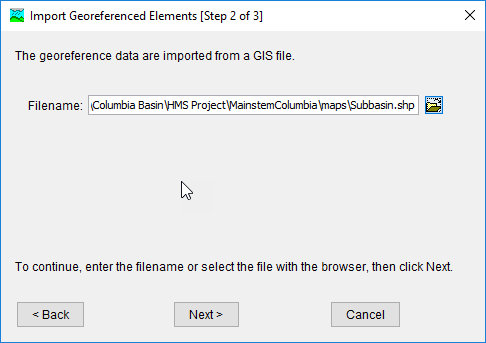
The figure below shows the third step of the Import Georeferenced Elements wizard. The user must choose a text field within the shape file's attribute table. Select the appropriate name field and click the Finish button. The program will import the elements in the shape file while also adding GIS features for those new element.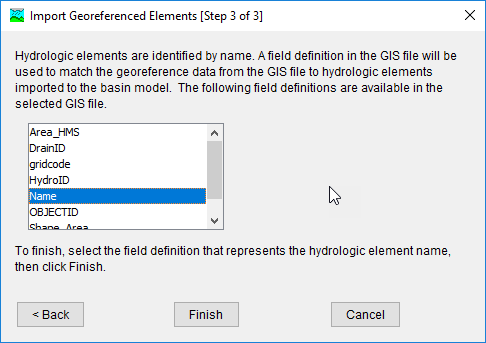
Export Layers
After completing some (or all) of the GIS workflow steps on the GIS menu, you may wish to export some of the resulting geospatial features for use outside of HEC-HMS. Several features can be exported as a shapefile using the GIS | Export Layers tool. When selecting the tool, you first will be prompted to select the layer type that you wish to export (shown below). Pressing Cancel will exit the export wizard. Pressing Next will take you to the second step of the process, exporting the selected element type.
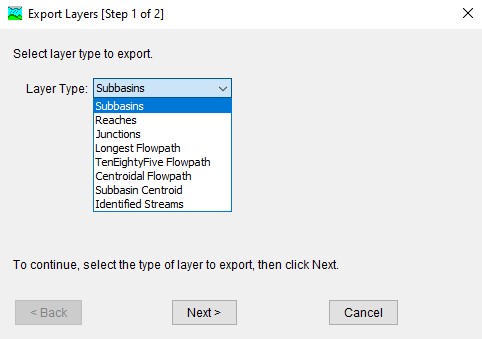
Note: if you wish to export junctions, you may want to use the Snap to Downstream tool first. This tool can be accessed by right-clicking on the Basin Model Map and selecting Junctions | Snap to Downstream. If junction elements have a reach as a downstream connection, this tool will ensure that they are snapped to the nearest end of the reach.
Exported features will be in ESRI shapefile format, and you need to specify the destination file path and name using the text field or browser on the second step of the wizard (shown below). If you select Back you can re-choose which element type you would like to export. Cancel will exit the wizard. Finish will create the exported shapefile in the specified location.

Compute Grid Cells
The program will automatically compute the subbasin Discretization when the Structured Discretization Method is selected (see Selecting a Discretization Method). The terrain preprocessing step must have been completed and the flow direction grid created before attempting to run GIS | Compute | Create Grid Cells. The structured grid can be displayed in the Basin Model Map by checking the Discretization layer in the Map Layers editor.
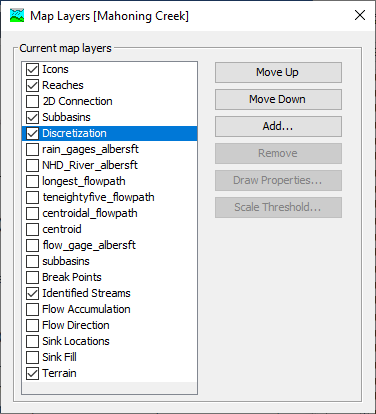
Create Grid Cell File
A Grid Cell File can be used to apply gridded precipitation to a Basin Model, or when using any of the gridded methods in the Meteorologic Model. A grid cell file can also be used by the ModClark transform method and any of the gridded loss methods. There is a option to create a grid cell file from the GIS menu. The grid cell file should only be created after delineating subbasin and reach elements, and updating element names with names that are appropriate for the study. The grid cell file must be re-created if any of the subbasin names are modified. The grid cell file option is no longer the preferred option for discretizing subbasin elements, either the Structured or Unstructured Discretization Methods should be used.
The figure below shows the first editor in the Create a Grid Cell File wizard that is opened by clicking GIS | Compute | Create Grid Cell File. The user must select the grid projection first, the options include Standard Hydrologic Grid (SHG) or one of the UTM projections. The user must also select the grid resolution from a drop down list. The grid resolution must match the resolution of all gridded meteorologic data-sets and any parameter grids. The figure below shows the second editor in the Create a Grid Cell File wizard. The user must select a file location and name for the grid cell file. By default, the file extension is *.mod. When clicking the Finish button, the program will create the user specified grid, intersect the grid with the subbasin boundaries, and create a text file containing the grid cells within each subbasin, their area, and their travel length. The travel length is computed using the flow direction grid. The program computes an area weighted travel length for each of the SHG or UTM grid cells.

